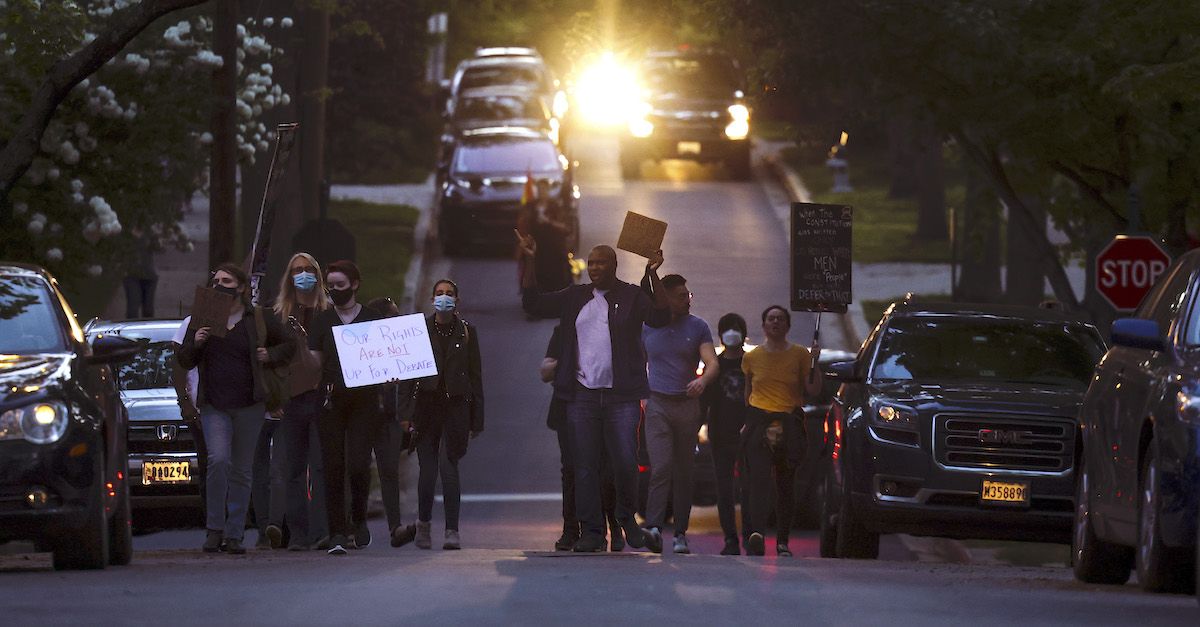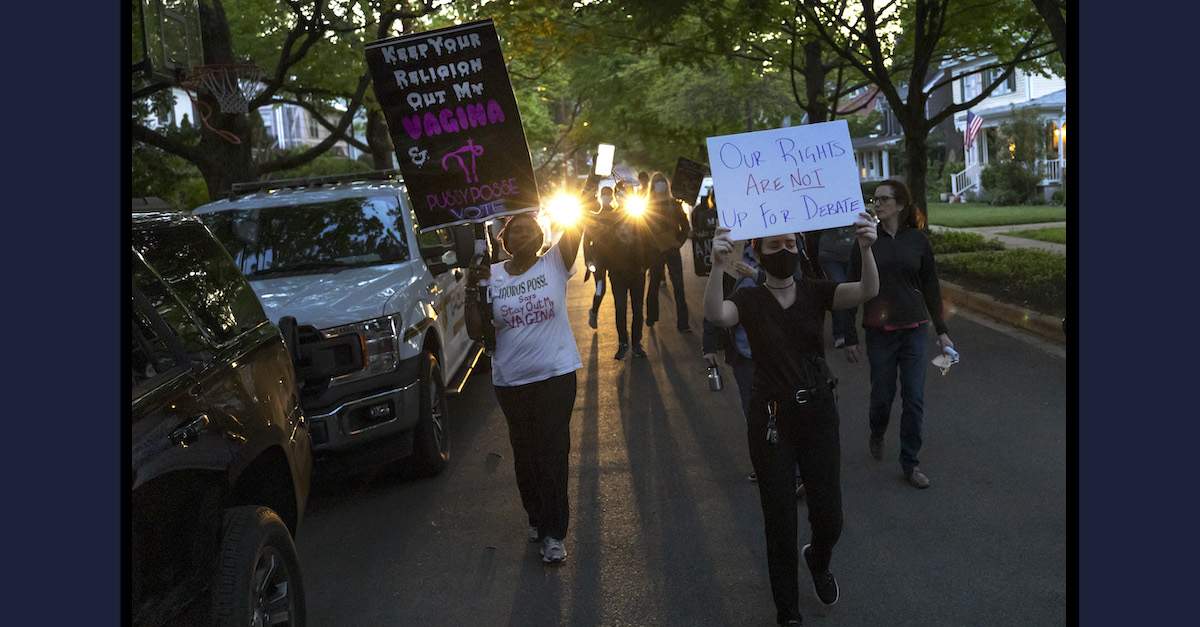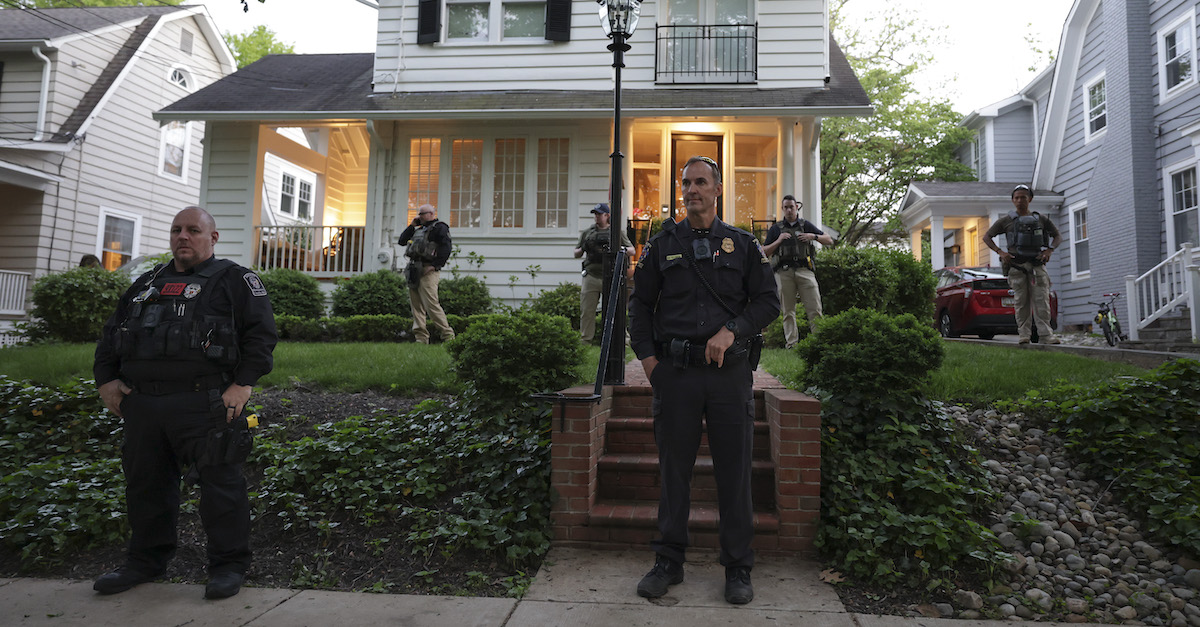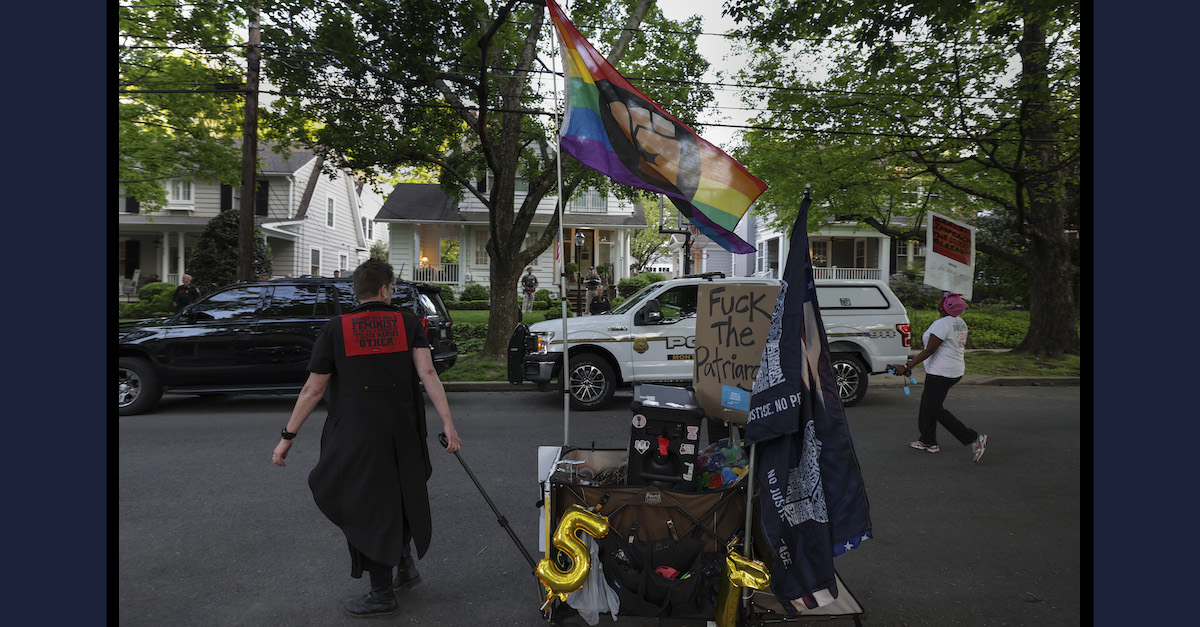
Abortion rights advocates stage a protest outside the home of U.S. Associate Supreme Court Justice Brett Kavanaugh on May 11, 2022 in Chevy Chase, Maryland. (Photo by Kevin Dietsch/Getty Images.)
While seeking to balance the First Amendment with the rights of due process and of the courts to function as a co-equal branch of government, the U.S. Supreme Court has signaled support for laws which criminalize picketing around judicial facilities — laws which might be used to prosecute those who protested outside the homes of several justices in the wake of a leaked draft opinion by Justice Samuel Alito that seeks to overturn Roe v. Wade.
Ironically enough, the relevant case law includes a previous Supreme Court decision that protected an abortion doctor against pro-life protesters.
Protests neared Alito’s home as well as the home of Justice Brett Kavanaugh, according to images on Twitter. FOX News reported that the homes of Justices Clarence Thomas, Neil Gorsuch, and Amy Coney Barrett were also involved. FOX said a group called “Ruth Sent Us” organized the protests — which they dubbed “Walk-by Wednesday.” The latter moniker for the protests themselves may be key to interpreting whether they violated any laws.
We have been coordinating with @FairfaxCountyPD, @VSPPIO, and federal authorities to ensure that there isn’t violence. Virginia State Police were closely monitoring, fully coordinated with Fairfax County and near the protests. https://t.co/SZMhbuzKFN
— Governor Glenn Youngkin (@GovernorVA) May 10, 2022
The protests ignited a firestorm of commentary, especially by conservatives and Republicans who wanted the protesters to be arrested and prosecuted. The governors of Maryland and Virginia, both of whom are Republicans, on Thursday asked for a clampdown on the protests.
As with many areas of law, the analysis of whether the protests amounted to a crime is fact-specific and highly dependent on the wording of the individual criminal statutes and ordinances at play. The bottom line is that the courts have looked favorably upon laws which protect the judiciary and juries from protests directly linked to judicial proceedings when they occur on the doorsteps of their workplaces or homes — but there are key caveats.
Let’s look at the statutes and constitutional cases that are most on point.

Abortion rights advocates stage a protest outside the home of U.S. Associate Supreme Court Justice Brett Kavanaugh on May 11, 2022 in Chevy Chase, Maryland. (Photo by Kevin Dietsch/Getty Images.)
One federal statute (and the analogous statutes of several states) bans “picketing or parading” with the “intent of influencing any judge.” The statute, 18 U.S.C. § 1507, reads as follows:
Whoever, with the intent of interfering with, obstructing, or impeding the administration of justice, or with the intent of influencing any judge, juror, witness, or court officer, in the discharge of his duty, pickets or parades in or near a building housing a court of the United States, or in or near a building or residence occupied or used by such judge, juror, witness, or court officer, or with such intent uses any sound-truck or similar device or resorts to any other demonstration in or near any such building or residence, shall be fined under this title or imprisoned not more than one year, or both.
Nothing in this section shall interfere with or prevent the exercise by any court of the United States of its power to punish for contempt.
A Virginia state statute supplies broader verbiage and prescribes, in part:
Any person who shall engage in picketing before or about the residence or dwelling place of any individual, or who shall assemble with another person or persons in a manner which disrupts or threatens to disrupt any individual’s right to tranquility in his home, shall be guilty of a Class 3 misdemeanor. Each day on which a violation of this section occurs shall constitute a separate offense.
The Virginia statute authorizes “damages, including punitive damages, against the persons found guilty of actions made unlawful by this section.”
“A person may not intentionally assemble with another in a manner that disrupts a person’s right to tranquility in the person’s home,” reads Maryland’s anti-picketing statute. That statute expressly says that “the protection and preservation of the home is the keystone of democratic government” and that the government’s goal is that “members of the community [should] enjoy in their homes a feeling of well-being, tranquility, and privacy.”
Both types of statutes have been the subject of notable litigation — and the U.S. Supreme Court has upheld the constitutionality of them.

Abortion rights advocates stage a protest outside the home of U.S. Associate Supreme Court Justice Brett Kavanaugh on May 11, 2022 in Chevy Chase, Maryland. Law&Crime has blurred the house number. (Photo by Kevin Dietsch/Getty Images.)
The federal statute traces its roots back to 1950 and was judicially discussed by the Supreme Court in Cox v. Louisiana (1965), a case which technically dealt with a state statute that similarly banned protests and known in legal quarters as Cox II. (Another case, Cox I, involved the same plaintiffs but different statutes.) The analogous state and federal statutes were passed, Cox II indicated, after “the picketing of federal courthouses by partisans of the defendants during trials involving leaders of the Communist Party.” The 5-4 opinion explains (with legal citations omitted):
This picketing prompted an adverse reaction from both the bar and the general public. A number of groups urged legislation to prohibit it. At a special meeting held in March 1949, the Judicial Conference of the United States passed the following resolution: “Resolved, That we condemn the practice of picketing the courts, and believe that effective means should be taken to prevent it.” A Special Committee on Proposed Legislation to Prohibit Picketing of the Courts was appointed to make recommendations to the Conference on this subject. In its Report to the Judicial Conference, dated September 23, 1949 . . . the Special Committee stated: “The sentiment of bar associations and individual lawyers has been and is practically unanimous in favor of legislation to prohibit picketing of courts.” Upon the recommendation of this Special Committee, the Judicial Conference urged the prompt enactment of the then-pending bill. Report of the Judicial Conference of the United States, 17-18 (1949). Similar recommendations were made by the American Bar Association, numerous state and local bar associations, and individual lawyers and judges.
Writing for the majority, Justice Arthur Goldberg called the statute a “precise, narrowly drawn regulatory statute which proscribes certain specific behavior.” The Court then heartily rationed that restrictions on protest activity connected to judicial proceedings were entirely constitutional (again, citations omitted):
There can be no question that a State has a legitimate interest in protecting its judicial system from the pressures which picketing near a courthouse might create. Since we are committed to a government of laws and not of men, it is of the utmost importance that the administration of justice be absolutely fair and orderly. This Court has recognized that the unhindered and untrammeled functioning of our courts is part of the very foundation of our constitutional democracy.
[ . . . ]
A State may adopt safeguards necessary and appropriate to assure that the administration of justice at all stages is free from outside control and influence. A narrowly drawn statute such as the one under review is obviously a safeguard both necessary and appropriate to vindicate the State’s interest in assuring justice under law.
Nor does such a statute infringe upon the constitutionally protected rights of free speech and free assembly. The conduct which is the subject of this statute—picketing and parading—is subject to regulation even though intertwined with expression and association. The examples are many of the application by this Court of the principle that certain forms of conduct mixed with speech may be regulated or prohibited.
Those “examples,” per the opinion, are “encouraging the commission of a crime,” “fighting words,” and certain types of picketing and parading in labor disputes.
The Cox II court then said some judges might be influenced by demonstrations and that they must be protected from their effects. It even went so far as to say that the state has a legitimate interest in assuaging the public perception that judges are malleable to the whims of protesters:
It is, of course, true that most judges will be influenced only by what they see and hear in court. However, judges are human; and the legislature has the right to recognize the danger that some judges, jurors, and other court officials, will be consciously or unconsciously influenced by demonstrations in or near their courtrooms both prior to and at the time of the trial. A State may also properly protect the judicial process from being misjudged in the minds of the public. Suppose demonstrators paraded and picketed for weeks with signs asking that indictments be dismissed, and that a judge, completely uninfluenced by these demonstrations, dismissed the indictments. A State may protect against the possibility of a conclusion by the public under these circumstances that the judge’s action was in part a product of intimidation and did not flow only from the fair and orderly working of the judicial process.
Cox II also said that the State of Louisiana could infer that the protests in question in 1965 had the “intent” of influencing a judicial proceeding — even though the individuals whose arrests were the subject of the protest had not been hauled before a judge. Thus, the “intent” of the protest could be rather broadly “presumed to intend to influence judges, jurors, witnesses or court officials,” the high court held.

Abortion rights advocates stage a protest outside the home of U.S. Associate Supreme Court Justice Brett Kavanaugh on May 11, 2022 in Chevy Chase, Maryland. (Photo by Twitter video screengrab.)
While Cox II upheld the basic constitutionality of the statutes in question, the Court threw out the convictions the case challenged. That’s because the police told the protesters they were free to protest where they were standing, which the opinion described as “on the west sidewalk, the far side of the street, exactly 101 feet from the courthouse steps and, judging from the pictures in the record, approximately 125 feet from the courthouse itself.”
The initial police acquiescence, the Court reasoned, was a form of “entrapment” that violated notions of due process:
Thus, the highest police officials of the city, in the presence of the Sheriff and Mayor, in effect told the demonstrators that they could meet where they did, 101 feet from the courthouse steps, but could not meet closer to the courthouse. In effect, appellant was advised that a demonstration at the place it was held would not be one “near” the courthouse within the terms of the statute.
However, the court limited the effect of a similar statute in U.S. v. Grace (1983). That statute, which has since apparently been moved to other areas of the federal criminal code, made it illegal “to parade, stand, or move in processions or assemblages in the Supreme Court Building or grounds” or “to display therein any flag, banner, or device designed or adapted to bring into public notice any party, organization, or movement.”
Grace did not precisely deal with public pressure aimed squarely at a judge but rather dealt with generalized leafletting about topics largely unconnected to the judiciary. Still, the Grace court spoke favorably of Cox II and held that the instant statute up for consideration could not constitutionally apply to public sidewalks on the perimeter of the Supreme Court’s facilities — even though it was originally written to do so.
Put another way, “the controversy presented by appellees concerned their right to use the public sidewalks surrounding the Court building for the communicative activities they sought to carry out,” the Court said in a unanimous opinion by Justice Byron White. “[W]e hold that § 13k [the then-statute in question] may not be applied to the public sidewalks.”
“The sidewalks comprising the outer boundaries of the Court grounds are indistinguishable from any other sidewalks in Washington, D. C., and we can discern no reason why they should be treated any differently,” the court elucidated while walking through the usual constitutional analytical steps. “Sidewalks, of course, are among those areas of public property that traditionally have been held open to the public for expressive activities and are clearly within those areas of public property that may be considered, generally without further inquiry, to be public forum property.”

Abortion rights advocates stage a protest outside the home of U.S. Associate Supreme Court Justice Brett Kavanaugh on May 11, 2022 in Chevy Chase, Maryland. (Photo by Kevin Dietsch/Getty Images.)
But Grace’s sidewalk rule does not present an immediate get-out-of-trouble card to the protesters on the streets and sidewalks outside the homes of the justices. Though the same constitutional amendment was at play, Grace explicitly noted that the underlying statute, then codified as 40 U.S.C. § 13k, dealt with generalized assemblages in a specific premises — the Supreme Court grounds — and a concept entirely separate from what critics might call the content-based restrictions found in 18 U.S.C. § 1507. While the majority holding in Grace cited Cox II favorably — “[w]e have regularly rejected the assertion that people who wish “to propagandize protests or views have a constitutional right to do so whenever and however and wherever they please” — a partial concurrence and partial dissent by Justice Thurgood Marshall drew attention to the distinction. Marshall argued that 40 U.S.C. § 13k should have been declared wholly unconstitutional but that 18 U.S.C. § 1507 was a more permissible ban on “conduct that is incompatible with the primary activity being carried out” in a courthouse.
In the ensuing years, other statutes have been used to prosecute people who interrupted Supreme Court oral arguments to protest and who chained the doors of a courthouse.
Perhaps most ironically, in the case of Frisby v. Schultz (1988), the Supreme Court upheld a Wisconsin ordinance that banned protests targeted at a specific house. The case arose when protests targeted an abortion doctor and questioned a law not terribly dissimilar from the overall goals of the Virginia and Maryland statutes cited above.
The Frisby court noted that “[g]eneral marching through residential neighborhoods, or even walking a route in front of an entire block of houses, is not prohibited by [the Wisconsin] ordinance.”
“Accordingly, we construe the ban to be a limited one; only focused picketing taking place solely in front of a particular residence is prohibited,” Justice Sandra Day O’Connor wrote in Frisby. “We readily agree that the ordinance preserves ample alternative channels of communication.”
O’Connor next discussed the government’s interest in “the protection of residential privacy.”
“The State’s interest in protecting the well-being, tranquility, and privacy of the home is certainly of the highest order in a free and civilized society,” O’Connor noted while citing an earlier case.
“One important aspect of residential privacy is protection of the unwilling listener. Although in many locations, we expect individuals simply to avoid speech they do not want to hear,” O’Connor continued, “the home is different.”
“Instead, a special benefit of the privacy all citizens enjoy within their own walls, which the State may legislate to protect, is an ability to avoid intrusions,” the first female justice continued.
Because the picketing prohibited by the Brookfield ordinance is speech directed primarily at those who are presumptively unwilling to receive it, the State has a substantial and justifiable interest in banning it. The nature and scope of this interest make the ban narrowly tailored. The ordinance also leaves open ample alternative channels of communication and is content neutral.
When synthesized into a relevant constitutional standard, the available case law suggests that picketing in a particular person’s generalized neighborhood or on sidewalks adjacent to court facilities cannot be generally prosecuted because such activity is protected under the First Amendment. However, Cox adds a significant wrinkle to the mix because it addresses a mix of conduct and content that is specifically aimed at judicial decisions — and the courts have heretofore looked favorably upon laws which protect the judiciary from the latter when it occurs on the doorsteps of their workplaces, at least.
[Images as noted.]
Have a tip we should know? [email protected]